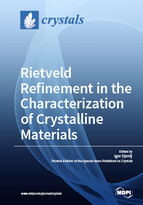Rietveld Refinement in the Characterization of Crystalline Materials
A special issue of Crystals (ISSN 2073-4352).
Deadline for manuscript submissions: closed (31 July 2018) | Viewed by 31082
Special Issue Editor
Interests: solid state chemistry; materials chemistry; condensed matter physics; magnetic properties; structure–property relationship; bandstructure calculation; sol-gel synthesis; crystal structure determination; three-way catalysts; functional materials; nanomaterials; perovskites; multiferroicity; metal–organic frameworks
Special Issues, Collections and Topics in MDPI journals
Special Issue Information
Dear Colleagues,
Nowadays, various crystalline materials are essential in our world due to their broad technological applications arising from their properties: ceramics in engineering, semiconductors in electronic industry, porous materials in catalysis and various families of compounds in sensor industry. In order to understand and tailor the properties of crystalline materials, the atomic structure has to be known. The common used techniques to do this are diffraction techniques using neutrons from neutron sources or X-rays from laboratory sources and synchrotrons. Most materials of technological interest appear in the polycrystalline form with strong tendency to consist of very small crystallites. For those system, the accurate determination of the crystal structure and microstructure has been routinely done using the Rietveld method.
The current special issue focuses on the implementation of the Rietveld refinement of powder X-ray or neutron diffraction data as an advanced analysis tool for the extraction of structural and microstructural features of various crystalline materials.
We look forward to receiving your contributions to these issue.
Prof. Dr. Igor Djerdj
Guest Editor
Manuscript Submission Information
Manuscripts should be submitted online at www.mdpi.com by registering and logging in to this website. Once you are registered, click here to go to the submission form. Manuscripts can be submitted until the deadline. All submissions that pass pre-check are peer-reviewed. Accepted papers will be published continuously in the journal (as soon as accepted) and will be listed together on the special issue website. Research articles, review articles as well as short communications are invited. For planned papers, a title and short abstract (about 100 words) can be sent to the Editorial Office for announcement on this website.
Submitted manuscripts should not have been published previously, nor be under consideration for publication elsewhere (except conference proceedings papers). All manuscripts are thoroughly refereed through a single-blind peer-review process. A guide for authors and other relevant information for submission of manuscripts is available on the Instructions for Authors page. Crystals is an international peer-reviewed open access monthly journal published by MDPI.
Please visit the Instructions for Authors page before submitting a manuscript. The Article Processing Charge (APC) for publication in this open access journal is 2600 CHF (Swiss Francs). Submitted papers should be well formatted and use good English. Authors may use MDPI's English editing service prior to publication or during author revisions.
Keywords
- Rietveld method
- Crystalline materials
- Functional materials
- Structural materials
- Microstructural analysis
- Structural characterization
- X-ray and neutron diffraction






